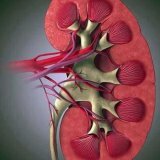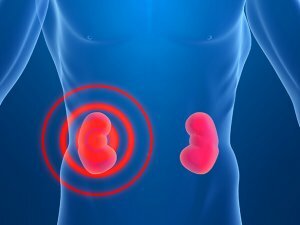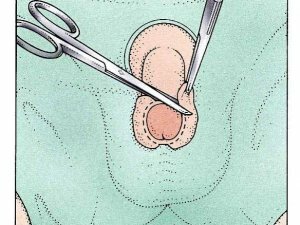Treatment of acute glomerulonephritis

Acute glomerulonephritis is a disease characterized by an infectious-allergic nature with the preferred damage to the capillaries of both kidneys. It is ubiquitous. Most often they are sick people aged 12 to 40 years, a little more often the disease affects men. The disease occurs in states with a damp and cold climate. The disease is seasonal in nature.
Definition of diagnosis.
Diagnosis of the acute form of diffuse glomerulonephritis does not pose serious complications in the case of a pronounced clinical picture of the disease, especially for young people. The most important is that often the leading symptoms in the overall picture of the disease are signs of heart failure( puffiness, dyspnea, cardiac asthma, etc.) In order to establish an accurate diagnosis in such cases, an important role can be played by the fact that the acute form of the disease is observed in patients without priorCardiac pathology and that in this case it is possible to detect a pronounced form of the urinary syndrome, especially hematuria, and in addition an increased tendency to bradycardia.
Difficult is the differential diagnosis between the acute form of glomerulonephritis and exacerbation of the chronic form of the disease. It is important to clarify the period from the time the infectious disease began to acute forms of nephritis. In the case of acute glomerulonephritis, this period is 1-23 weeks, and in case of an exacerbation of the chronic process - only a few days( 1-2 days).Equally in terms of severity, there may be a urinary syndrome, but a steady decrease in the relative density of urine is lower than 1.015, and a decrease in filtration renal function is more characteristic in the case of exacerbation of the chronic form of the disease. It is difficult to diagnose the latent form of acute glomerulonephritis. With the prevalence of red blood cells over the leukocytes in the urine sediment, in the absence of pale and active leukocytes( in the case of staining in Sterlingimer-Malbin), in the absence of a history of dysuric phenomena, you can distinguish the disease from a chronic form, latent pyelonephritis. The data obtained as a result of x-ray-urological studies may have considerable weight for a differential diagnosis with pyelonephritis, as well as renal stone disease, renal tuberculosis and other diseases that occur with a small urinary syndrome.
What to do in case of illness?
As a result, diet and bed rest are prescribed. The early restriction of the presence of table salt in food( not more than 1.5-2 g / day) in itself can cause increased water release and eliminate edema and hypertension syndrome. In the first period are appointed so-called. Sugar days( about 400-500 grams of sugar a day with 500-600 ml of tea or fruit juice).Subsequently, give pumpkins, watermelons, potatoes, oranges, which contribute to almost completely uninvited food.
Prolonged restriction of protein intake in case of acute glomerulonephritis is insufficiently justified, since delays in nitrogenous slags can not be observed most often, and sometimes the expected increase in blood pressure under the influence of protein nutrition is unproven. If it is a question of protein products, it is best to eat cottage cheese, and also egg white. Fats are allowed to be consumed in amounts of 50-80 grams / day. In order to provide a daily calorie intake, carbohydrates are added to the food. The liquid is allowed to consume about 600-1000 ml / day. Antibacterial treatment of acute glomerulonephritis in the case of an obvious association of the disease with an existing infection, for example, in the case of prolonged septic endocarditis, chronic tonsillitis. In the case of chronic tonsillitis, tonsillectectomy is shown 2-3 months after the acute forms of glomerulonephritis subsided.
Admission of hormones.
It is desirable to use steroid hormones - triamcinolone and prednisolone. Treatment of glomerulonephritis is prescribed no earlier than 3-4 weeks after the onset of the disease, when the overall symptomatology is less pronounced. Specifically shown are the corticosteroids in the case of nephrotic form or tightened flowing acute forms of glomerulonephritis, and in addition in the case of m. N.Residual urinary syndrome, including hematuria. Prednisolone is used, starting with a dosage of 10-20 mg / day, will soon( within a week or 10 days), adjusted to the daily rate of up to 60 mg. This dose is given for 2-3 weeks, then it gradually decreases. Treatment of acute disease is 5-6 weeks. The total number of prednisolin per course is 1500-200 mg. If not then reach the therapeutic effect can be prolonged therapy support prednizolina dosages( 10-15 mg / day) continuously under medical control. Corticosteroid treatment affects both puffiness and urinary syndrome. It can influence the recovery and prevention of the transition of the acute form to the chronic. Moderate hypertension is not contraindicated in the use of corticosteroids. In the case of the upward trend in blood pressure buildup and swelling corticosteroids therapy should be combined with diuretics and antihypertensive drugs. If the body has foci of infection, then along with corticosteroid hormones, antibiotics should be prescribed.
In the case of arterial hypertension and, in particular, in the formation eclampsia shown is complex hypertensive treatment of peripheral vasodilators( hydralazine, verapamil, diazoxide, nitroprusside) or sympatholytic( clonidine, reserpine), combined with a saluretikami( ethacrynic acid, furosemide), andand tranquilizers( diazepam, etc.) may be used together with ganglionic blockers. To reduce cerebral edema, osmotic diuretics are used( mannitol, 40% glucose solution).In the case of convulsions( at 1 stage), an ether-oxygen anesthesia is given. With prolonged convulsions, bloodletting is performed.



